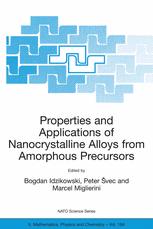

Most ebook files are in PDF format, so you can easily read them using various software such as Foxit Reader or directly on the Google Chrome browser.
Some ebook files are released by publishers in other formats such as .awz, .mobi, .epub, .fb2, etc. You may need to install specific software to read these formats on mobile/PC, such as Calibre.
Please read the tutorial at this link: https://ebookbell.com/faq
We offer FREE conversion to the popular formats you request; however, this may take some time. Therefore, right after payment, please email us, and we will try to provide the service as quickly as possible.
For some exceptional file formats or broken links (if any), please refrain from opening any disputes. Instead, email us first, and we will try to assist within a maximum of 6 hours.
EbookBell Team

5.0
98 reviewsMetallic (magnetic and non-magnetic) nanocrystalline materials have been known for over ten years but only recent developments in the research into those complex alloys and their metastable amorphous precursors have created a need to summarize the most important accomplishments in the field. This book is a collection of articles on various aspects of metallic nanocrystalline materials, and an attempt to address this above need.
The main focus of the papers is put on the new issues that emerge in the studies of nanocrystalline materials, and, in particular, on (i) new compositions of the alloys, (ii) properties of conventional nanocrystalline materials, (iii) modeling and simulations, (iv) preparation methods, (v) experimental techniques of measurements, and (vi) different modern applications. Interesting phenomena of the physics of nanocrystalline materials are a consequence of the effects induced by the nanocrystalline structure. They include interface physics, the influence of the grain boundaries, the averaging of magnetic anisotropy by exchange interactions, the decrease in exchange length, and the existence of a minimum two-phase structure at the atomic scale.
Attention is also paid to the special character of the local atomic ordering and to the corresponding interatomic bonding as well as to anomalies and particularities of electron density distributions, and to the formation of metastable, nanocrystalline (or quasi-crystalline) phases built from exceptionally small grains with special properties. Another important focus of attention are new classes of materials which are not based on new compositions, but rather on the original and special crystalline structure in the nanoscale.